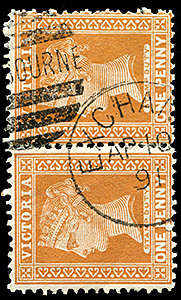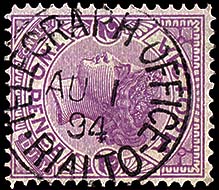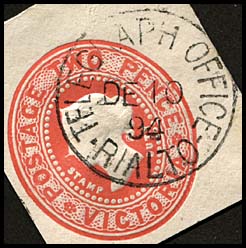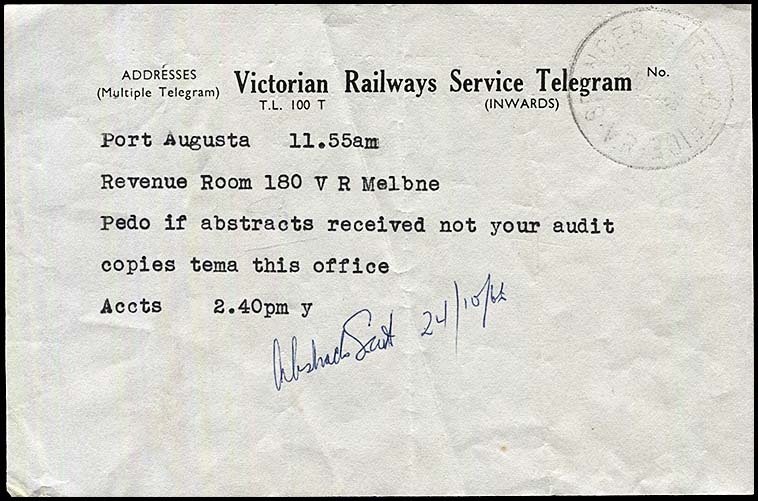Telegraph Offices in Melbourne City.
- Home, index, site details
- Australia 1901-1988
- New South Wales
- Overview of NSW
- Telegraph lines
- Telegraph Offices
- Date stamps
- Forms
- Envelopes
- Rates
- Stamps
- Queensland
- Overview of Qld
- Telegraph lines
- Telegraph offices
- Date stamps
- Forms
- Envelopes
- Rates
- Stamps
- South Australia
- Overview of SA
- Telegraph lines
- Telegraph Offices
- Date stamps
- Forms
- Envelopes
- Rates
- Stamps
- Tasmania
- Overview of Tasmania
- General developments
- Reports
- Organisation
- Telegraph lines
- Telegraph Offices
- Date stamps
- Railway lines
- Forms
- Envelopes
- Rates
- Stamps
- Overview of Tasmania
- Victoria
- Overview of Vic.
- Telegraph lines
- Telegraph offices
- Date stamps
- Forms
- Envelopes
- Rates
- Stamps
- Ephemera
- Western Australia
- Overview of WA
- Telegraph lines
- Telegraph Offices
- Date stamps
- Forms
- Envelopes
- Rates
- Stamps
By the end of 1880, there were seven offices - apart from the Central Telegraph Office - operating within the city. Two more Telegraph Offices were added later.
|
On 15 July 1872, a branch Telegraph Office was opened at the eastern end of Customs House to facilitate the access by merchants to telegraph and money order facilities after the removal of the Chief Telegraph Office to new premises on the corner of Elizabeth and Little Bourke Streets. Telegrams were still sent and received at the head office and messages were carried between offices on horseback. Two horses were used each way with a transit time of between five to seven minutes. Almost immediately on the opening of the office, a deputation from the Melbourne Stock Exchange waited upon the Postmaster-General to ask him to erect a line to the Hall of Commerce in Collins Street, for the convenience of the brokers. "Mr. Langton remarked that he failed to see how a separate wire to such a branch would facilitate the despatch of business to the chief mining centres, as communications sent to the telegraph station at the Post Office, where there were seven wires to Ballarat and five to Sandhurst, stood a much better chance of being sent away without delay than if they had to wait their turn by a single wire at the branch office. The deputation then requested that private boxes, similar to those to be obtained at the Post Office, might be constructed at the Hall of Commerce, and that messages arriving for the brokers who possessed them might be dropped into the boxes by the telegraph messengers. Mr. Langton promised to consider the application. In connexion with this matter, Mr. James, of the Telegraph Department, made a suggestion which, if adopted, would prove of great convenience to the brokers. It was that a pneumatic tube should be laid between the telegraph Office and the Hall of Commerce and that messages arriving for the brokers should be sent direct from the office by that means and deposited by a clerk at the hall in the private boxes before mentioned". A pneumatic tube system was eventually laid down between the offices. On 29 April 1876, the Deputy Postmaster-General Mr Turner announced that the Post Office and Electric Telegraph Office at the branch office in William Street was removed to the south-east corner of Customs House "where the letter receiving pillar is also placed". Finally a wire linking the Chief Telegraph Office to Customs House was erected during 1879. It overcame the need to deliver messages using mounted messengers. |
|
The Post & Telegraph Office was formerly Commerce House which had been opened on 8 July 1914. The change of name to Degraves Street was effected on 17 November 1956. On 29 August 1986, the name changed again to Flinders Lane. |
|
A rubber circular TELEGRAPH date stamp was used over two time periods and in different inks.
|
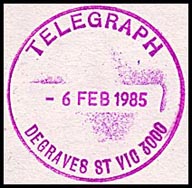 6 February 1985 (earliest recorded date). |
|
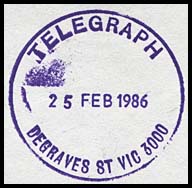 25 February 1986 (only recorded date). |
Eastern Market. On 8 January 1880, The Argus reported that "a branch Telegraph Office, Post Office, Receiving House, Money Order office and Savings Bank have been opened at the Eastern Market, corner of Bourke and Stephen streets. Telegraphic communication has also been extended to Morang, on the Plenty Road. These offices are now available to the public". |
|
This branch Post & Telegraph Office was opened in August 1879 by erecting a building "on a portion of the reserve at the junction of Elizabeth Street North and Victoria Street occupied by the Department as a storeyard". |
|
The Telegraph Office opened during 1861 or 1862. In December 1880, 2,661 messages with a value of £223 3s 6d were sent. On 9 August 1881, the Argus reported that Mr. P. R. Challen, who represented the Post & Telegraph Department at the Melbourne International Exhibition had been appointed to rhe charge of the Telegraph Branch at the Exchange, Collins Street West. The Office was reclassified as a Post Office about June 1891. This office was in direct communication with the principal mining centres. It was renamed the Stock Exchange in 1893. |
||
No special date stamp inscribed TELEGRAPH was issued the this office. Instead a duplex was used.
|
|
|
The Age of 20 August 1859 reported on the meeting of Directors of the Exchange. In part, this noted:
The Ballarat Star of 23 June 1863 reported that
See the above discussion on Customs House and the later developments after the Exchange was renamed the Stock Exchange in 1893. |
||
|
The Telegraph Office at the Exhibition Building was opened on 18 August 1880 with the Post Office opening on 20th. The two offices closed on 30 April 1881. The Post Office for the second Exhibition operated from 16 July 1888 to 1889. The Telegraph and Post Offices continued to operate in the premises without the major exhibitions. The Geelong Advertiser reported on 28 January 1899 that "Acting under instructions from the Geelong Town Council, Mr H. F. Richardson, as agent for the lessee of the Exhibition buildings, has given the Postal Department notice to give up possession of the office they occupy in the buildings, and the Department has accepted same, and will close the office from and after the 19th proximo. The Telegraph Office in the Exhibition Buildings in the past has been a great convenience to a large section of the business people, and to those in a hurry to catch the steamers and train and yet, without any sense or reason, the office is objected to by a clique who have closed the Exhibition Theatre". |
||
A 1 hole Belt & Buckle date stamp was used at the Exhibition Post & Telegraph Office.
|
 23 October 1888. |
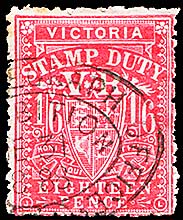 31 December 1888 (latest recorded date). |
|
Flinders Street was the first railway station in an Australian City - opened on 12 September 1854 as the Melbourne Terminus. The imposing and well-known structure was finally completed in 1909. After a second platform was added in 1877, a Telegraph Office was opened in 1879. Nothing further The Telegraph Office opened about 1898 but was reclassified as a Post Office about 1915. It closed the following year. The Office was issued with two formats of a circular steel FLINDERS ST TEL OFFICE V-R:
|
Hobsons Bay Railway Station This Branch Telegraph Office was fitted up and opened in April 1879. |
| Law Courts.
Built in 1878 at the corner of Lonsdale and William Street. The building was renamed the Supreme Court.
|
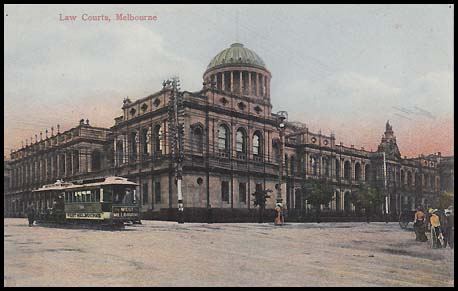 |
Two types of date stamps were used in relation to telegraphs:
|
 15 March 1892. |
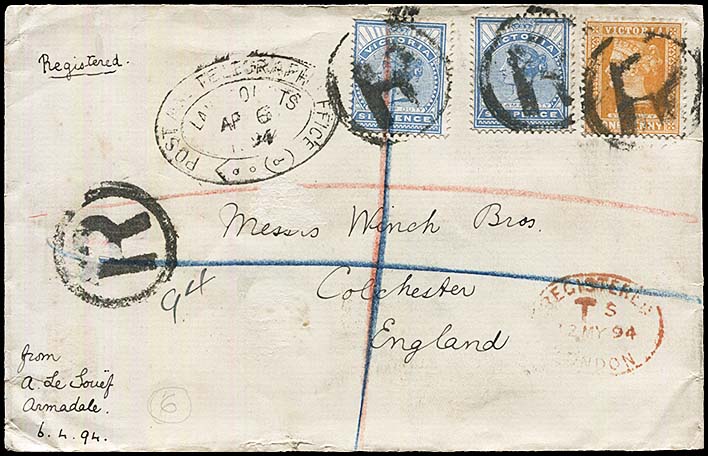 6 April 1894 (latest recorded date). One of three covers with a Belt & Buckle sent to an overseas destination - see also Horsham and Market Street below. |
|
|
 14 August 1975. |
| Market Street.
The Telegraph Office opened in August 1872. A one hole Belt & Buckle date stamp was used in black with telegraphs and with ordinary mail:
|
 20 June 1894. Used on 6d Stamp Statute on piece. Provenance: Hugh Freeman. |
|
|
Parliament House.
|
Public Offices (Spring Gardens).
|
|
The Office was issued with a one hole Belt & Buckle date stamp.
|
 12 September 1890. |
| The Rialto.
"The Rialto" was opened in 1891 as a Receiving Office with telegraph facilities. The name changed to "Rialto" in 1902 and was again renamed - as King Street - on 19 November 1965. |
|||
Three formats of TELEGRAPH or TO date stamps were used at the Office:
Characteristics:
|
|
|
|
 23 September 1902. |
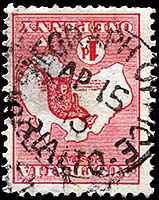 15 April 1913. |
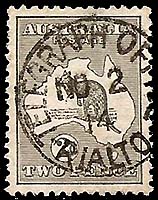 2 November 1914. |
|
|
|||
Characteristic: a one line date.
|
 31 March 1919. |
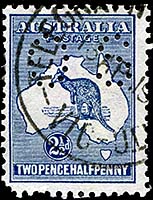 18 April 1919. |
|
Characteristics:
|
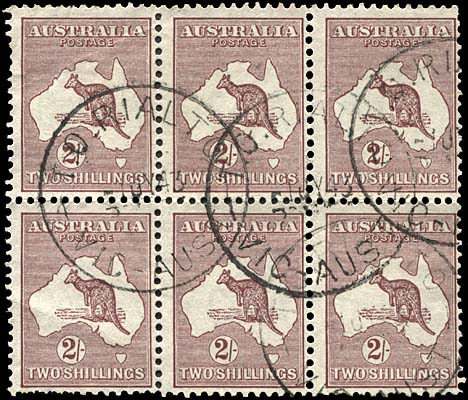 1 July 1943. |
||
| Spencer Street Station.
The Station was opened in 1859. The Telegraph Office opened in October 1861 while the Post Office opened about 1886. The offices were closed on 31 August 1977. |
|||
The first recorded date stamp was inscribed Spencer Street RS/ It has a two line date with a two digit year. There are filled dots near the outside ring. Used: 3 October 1904. Diameter: 27 mm. |
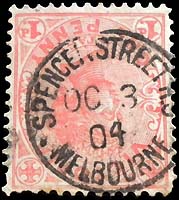 3 October 1904. |
|
|
The first of three formats for a Telegraph Office date stamp was inscribed
|
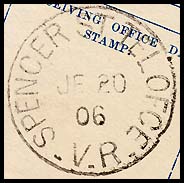 20 June 1906. Used on VI-DO-1D. |
||
|
|
|
|
|
 9 January 1968. Cancelling 40c Tasman punctured VG on a piece of a telegram form. |
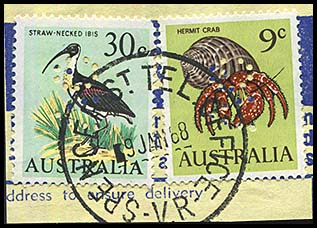 9 January 1968 (latest recorded date). Cancelling 30c Ibis and 9c Hermit Crab (both punctured VG) on piece of telegram form. |
|
 24 October 1966. Used on Railways Telegram Form below. |
|||
|
|||
The Sydney Morning Herald of 30 December 1899 reported that:
|
|
The Exchange Telegraph Office was opened in December 1880. The Stock Exchange Telegraph Office was created when the Exchange was renamed about 1893. In 1901, the office became a Receiving Office and then (in June) a Post Office. It reverted to its original status as a Telegraph Office on 1 September 1925. The office was closed on 11 October 1968. |
 |
||
A 2 hole Belt & Buckle date stamp was issued to the Office:
|
 18 April 1902. |
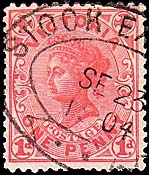 23 September 1904. |
 13 October 1904. |
| The usual postal date stamps were used on telegrams from about the second half of 1909. | 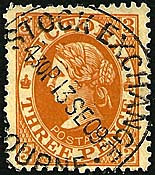 13 September 1909. Melbourne at base. |
 8 June 1915. VIC at base. |
|
